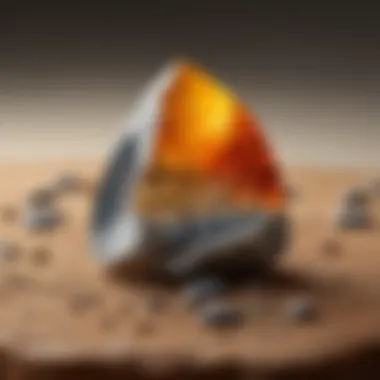Unraveling the Rock Hardness Scale: A Comprehensive Guide for Rock and Fossil Enthusiasts


Rock and Fossil Identification
Understanding rocks and fossils is paramount for collectors to differentiate between various geological specimens accurately. Rocks come in different types, such as igneous, sedimentary, and metamorphic, each with distinct characteristics. Fossils, on the other hand, offer a glimpse into prehistoric life forms preserved in sedimentary rock layers. To identify rocks and fossils effectively, collectors need to observe properties like color, texture, grain size, and mineral composition. Utilizing tools like geologist hammers, hand lenses, and field guides enhances the identification process, aiding in the categorization of specimens.
Collecting Tips and Techniques
Mastering the art of collecting rocks and fossils involves following best practices to ensure the preservation of these natural treasures. Experienced collectors recommend researching and locating prime collecting sites rich in geological diversity. When extracting specimens, it is crucial to use safe techniques to avoid damaging both the specimen and the surrounding environment. Employing tools like chisels, brushes, and safety goggles improves extraction precision and minimizes potential hazards associated with collecting.
Preservation and Display
Preserving rocks and fossils requires careful consideration of techniques to maintain their integrity and prevent deterioration. Collectors may opt for methods like cleaning with gentle brushes, gluing fragile pieces, or casting replicas for delicate specimens. Storing these treasures in acid-free containers with padded interiors safeguards against external damage and ensures longevity. When it comes to creative display ideas, utilizing shadowboxes, custom stands, or themed arrangements can elevate the aesthetic appeal of rock and fossil collections, providing a captivating showcase for enthusiasts.
Geological Insights
Exploring the geological insights garnered from rocks and fossils uncovers the intricate formations and processes that have shaped Earth's history. Geological formations like mountains, caves, and valleys offer glimpses into the dynamic forces at play beneath the surface. Delving into the historical significance of rocks and fossils reveals their role in evolutionary studies, paleontological research, and reconstructing past environments. Significant discoveries, such as the identification of new species or rare mineral deposits, contribute to scientific knowledge and broaden our understanding of the Earth's complex geological past.
Introduction to Rock Hardness
Rock hardness is a fundamental concept in the realm of geology, playing a crucial role in mineral identification and specimen categorization. Understanding the varying degrees of rock hardness allows rock and fossil collectors to discern between different types of rocks, aiding in their collection and study endeavors. By exploring the intricacies of rock hardness, enthusiasts can elevate their knowledge of geological formations and the geosciences at large.
Importance of Rock Hardness
Definition of Rock Hardness
The definition of rock hardness refers to the measure of a rock's resistance to scratching or abrasion. This characteristic is pivotal in geology as it helps in distinguishing between various types of rocks based on their hardness levels. The Mohs Scale, a widely recognized hardness scale, assigns numerical values to minerals based on their scratch resistance, aiding collectors in identifying and classifying rocks effectively. Understanding the definition of rock hardness is essential for enthusiasts as it forms the foundation for differentiating between rock types accurately.
Significance in Geology
The significance of rock hardness in geology lies in its role as a key indicator of a rock's composition and formation processes. Different rocks have varying hardness levels, influenced by factors like mineral content, crystalline structure, and environmental conditions during their formation. Geologists utilize rock hardness to interpret the geological history of a region, identify mineral deposits, and comprehend the evolution of landforms over time. Recognizing the significance of rock hardness equips collectors with the knowledge needed to interpret the geological significance of their findings.
Practical Applications
Practical applications of rock hardness encompass a wide range of geological activities, from field exploration to laboratory analysis. In the field, rock hardness serves as a valuable tool for identifying rocks and minerals based on their physical properties. Geologists and collectors use hardness testing to differentiate between similar-looking specimens and determine their geological context. Moreover, understanding rock hardness aids in conservation efforts, as it enables collectors to prioritize delicate specimens and ensure their long-term preservation. Recognizing the practical applications of rock hardness empowers enthusiasts to make informed decisions regarding specimen collection and study.
Historical Development
Origins of Rock Hardness Scale


The origins of the rock hardness scale can be traced back to ancient civilizations where minerals were assessed based on their scratch resistance. Early mineralogists developed rudimentary hardness scales to rank minerals by their relative hardness levels, laying the groundwork for modern-day hardness classification systems. Over time, these scales evolved into more standardized forms, such as the Mohs Scale, which revolutionized the way minerals were evaluated and categorized. Understanding the origins of the rock hardness scale provides collectors with historical context and appreciation for the advancements in mineralogical science.
Evolution Over Time
The evolution of rock hardness measurement techniques has been marked by continuous refinement and innovation. From the simple scratch test methods used by early mineralogists to the sophisticated hardness testing instruments employed today, the assessment of rock hardness has become more precise and systematic. Advances in technology have enabled geologists to measure hardness accurately, leading to a deeper understanding of mineral properties and geological formations. Studying the evolution of rock hardness measurement techniques offers collectors insights into the scientific progress made in the field of mineralogy and geology.
Key Concepts
Mohs Scale of Hardness
The Mohs Scale of Hardness, devised by Friedrich Mohs in 1812, remains one of the most widely used hardness scales in mineralogy. This scale ranks minerals from 1 (the softest) to 10 (the hardest) based on their relative scratch resistance. Collectors rely on the Mohs Scale to identify minerals and assess their durability, aiding in the identification of unknown specimens and the classification of mineral collections. Understanding the Mohs Scale of Hardness equips enthusiasts with a standardized method for evaluating mineral hardness and comparing different minerals effectively.
Other Hardness Scales
In addition to the Mohs Scale, various other hardness scales exist in geology, each tailored to specific types of materials or testing conditions. Scales like the Vickers Hardness Scale or the Rockwell Hardness Scale offer alternative methods for measuring hardness in different materials, providing more nuanced assessments in specialized applications. Exploring these alternative hardness scales broadens collectors' understanding of hardness assessment techniques and enables them to apply diverse approaches to mineral identification and characterization.
Understanding Mohs Scale
In this article, an in-depth analysis of the Mohs Scale of Hardness is crucial for rock and fossil collectors to comprehend the varying degrees of rock hardness. Understanding the Mohs Scale enables collectors to categorize rocks and fossils based on their hardness levels accurately. By delving into the specifics of the Mohs Scale, enthusiasts can appreciate the significance of hardness in geology and its practical applications in identifying and classifying geological specimens. It is imperative for rock and fossil collectors to grasp the Mohs Scale thoroughly to enhance their knowledge and appreciation of different rock types.
Mohs Hardness Scale Explained
Composition and Structure
The Composition and Structure aspect of the Mohs Hardness Scale refer to the arrangements of molecules and atoms within a mineral that contribute to its overall hardness. Understanding the composition and structure of minerals assists collectors in differentiating between various rocks based on their inherent hardness properties. The key characteristic of this aspect lies in its ability to provide insights into the mineral's resistance to abrasion and scratching. By comprehending the composition and structure, collectors can make informed decisions when identifying rocks and fossils, enhancing their accuracy and precision in classification. Despite its complexity, the Composition and Structure aspect offers valuable insights into determining the hardness of geological specimens, creating a foundation for effective rock and fossil collection strategies.
How It Works
Explaining how the Mohs Hardness Scale works is essential in enabling collectors to assign a numerical value to the hardness of a specific mineral. The key characteristic of this aspect is its simplicity and practicality, allowing collectors to conduct quick and reliable hardness assessments in the field. By understanding how the Mohs Scale operates, collectors can streamline the process of identifying minerals by conducting comparative hardness tests. This feature significantly benefits collectors by providing a standardized method for assessing hardness levels, facilitating accurate mineral identification. Despite its advantages, collectors must be aware of the potential limitations in certain testing scenarios, ensuring comprehensive evaluations of the hardness of geological specimens.
Application in Mineralogy
Identifying Minerals
The Application of the Mohs Scale in mineralogy is instrumental in the precise identification of minerals based on their hardness characteristics. The key characteristic of using the Mohs Scale for identifying minerals is its empirically derived ranking system, which correlates hardness levels to specific minerals. This methodology allows collectors to compare the scratch resistance of unknown minerals to the standardized hardness values, aiding in their accurate identification. The unique feature of this aspect lies in its universality, enabling collectors worldwide to apply the Mohs Scale consistently in mineral identification processes. Despite its advantages, collectors should exercise caution in cases where minerals possess closely similar hardness values, requiring additional testing methods for definitive identification.
Comparative Analysis
Performing a Comparative Analysis using the Mohs Scale assists collectors in distinguishing between minerals with varying hardness levels accurately. The key characteristic of this aspect is its ability to highlight the disparities in scratch resistance among minerals, facilitating comparative assessments. By comparing the hardness of minerals using the Mohs Scale, collectors can discern subtle differences in hardness, aiding in the identification of mineral specimens. The unique feature of this analysis lies in its practicality and accessibility, making it a popular choice for collectors seeking to evaluate the hardness of multiple minerals efficiently. Despite its advantages, collectors should interpret comparative results cautiously, considering external factors that may influence hardness test outcomes for more accurate mineral categorization.


Practical Implications
Rock hardness serves as a fundamental concept in the realm of geology, particularly for collectors of rocks and fossils. Understanding the practical implications of rock hardness is crucial for enthusiasts seeking to identify, categorize, and appreciate geological specimens. By comprehending rock hardness, collectors can differentiate between various rocks based on their hardness levels, enabling them to classify their collections more effectively. Additionally, knowledge of rock hardness aids in determining the durability and strength of rocks, providing insights into their formation and geological history. Overall, the practical implications of rock hardness play a significant role in enhancing the collecting experience and expanding one's geological knowledge.
Fieldwork and Specimen Identification
Field Application
The field application of rock hardness is a key element in geological explorations and specimen identification. Fieldwork allows collectors to observe rocks in their natural environments, facilitating the direct assessment of their hardness levels. By conducting hardness tests on-site, collectors can immediately determine the relative hardness of rocks, aiding in quick identification and classification. The portability and convenience of performing hardness assessments during fieldwork make it a popular choice among collectors, as it offers real-time insights into the geological properties of rocks. Despite its advantages, field application may be limited by environmental factors and the availability of testing equipment, requiring collectors to adapt their methods based on specific field conditions.
Case Studies
The inclusion of case studies in rock hardness analysis is instrumental in elucidating practical applications and enhancing understanding. By examining real-world examples of varying rock hardness levels, collectors gain valuable insights into the geological characteristics and formation processes of different rocks. Case studies offer a comparative analysis of rocks with different hardness ratings, allowing collectors to discern patterns and correlations within their collections. Additionally, case studies present challenges and complexities that collectors may encounter when assessing rock hardness, fostering a deeper understanding of the subject. Through the in-depth analysis of case studies, collectors can refine their skills in specimen identification and expand their knowledge of rock hardness variation.
Tools and Techniques
Hardness Testing Instruments
Hardness testing instruments are essential tools for evaluating the hardness of rocks accurately and quantitatively. These instruments provide a reliable method for determining the absolute hardness of rocks based on standardized scales such as Mohs Scale. The key characteristic of hardness testing instruments lies in their precision and repeatability, ensuring consistent hardness measurements across different samples. The use of hardness testing instruments offers a quantitative approach to rock hardness assessment, allowing collectors to obtain numerical data for comparison and analysis. While hardness testing instruments offer precise measurements, they may require calibration and proper maintenance to ensure accurate results.
Sample Preparation
Sample preparation is a critical component of rock hardness analysis, involving the careful selection and treatment of specimens for testing. Proper sample preparation ensures that rocks are presented in a uniform and suitable manner for hardness assessments. The key characteristic of sample preparation is its influence on the accuracy and reliability of hardness measurements, as poorly prepared samples may yield inconsistent results. By optimizing sample preparation techniques, collectors can minimize external factors that could impact hardness assessments, leading to more reliable and reproducible outcomes. However, sample preparation may introduce a level of subjectivity, as different preparation methods could affect the perceived hardness of rocks.
Preservation and Conservation
Best Practices
Adhering to best practices in rock hardness preservation is essential for maintaining the integrity and longevity of geological specimens. Best practices encompass proper handling, storage, and display techniques that aim to minimize physical damage and deterioration of rocks. The key characteristic of best practices is their emphasis on preventive measures to protect rocks from potential harm, such as corrosion, erosion, or contamination. By following best practices, collectors can ensure the sustainability of their collections and preserve the intrinsic value of rare or fragile specimens. While best practices promote the long-term conservation of rocks, they may require continuous monitoring and adjustments to account for evolving preservation standards.
Environmental Considerations
Environmental considerations play a critical role in the preservation and conservation of rocks, highlighting the impact of external factors on geological specimens. Collectors need to account for environmental conditions such as temperature, humidity, and exposure to sunlight, as these variables can affect the stability and aesthetics of rocks. The key characteristic of environmental considerations is their focus on creating conducive environments for rock storage and display, mitigating potential risks of degradation. By addressing environmental factors, collectors can prolong the lifespan of their collections and ensure the sustainability of delicate or valuable specimens. However, environmental considerations may pose challenges in maintaining controlled conditions, requiring collectors to implement creative solutions for optimal rock preservation.
Advanced Concepts
In this section of the comprehensive guide on Understanding Rock Hardness Scale, we delve into the critical topic of Advanced Concepts. This segment plays a pivotal role in enhancing the reader's comprehension of rock and fossil collection by providing in-depth insights into the nuances of hardness assessment. Exploring Advanced Concepts enables enthusiasts to distinguish between the attributes of hardness and toughness, offering a sophisticated understanding indispensable for geological studies and specimen analysis. By shedding light on the intricacies of hardness assessments, this section equips rock collectors with the knowledge required to identify and categorize specimens accurately, elevating their expertise in the field.


Hardness vs. Toughness
Distinguishing Factors
Delving into the realm of Distinguishing Factors reveals the essence of hardness and toughness disparities in rock evaluation. The key characteristic lies in understanding the material's resistance to deformation or scratching, showcasing how hardness reflects the mineral's durability under pressure. This aspect aids in differentiating between varying rock types based on their ability to withstand external forces, a crucial consideration for collectors analyzing geological samples. The unique feature of Distinguishing Factors lies in its capacity to unveil the innate properties of rocks, allowing enthusiasts to discern their structural integrity and formation history. Understanding these factors offers a nuanced perspective on specimen characteristics, facilitating informed decisions during classification endeavors.
Relevance in Geology
The significance of Relevance in Geology within the context of rock hardness assessment cannot be understated. This element contributes substantially to the overarching goal of deciphering mineral properties and geological formations accurately. By emphasizing the role of hardness in identifying rock types and understanding their formation processes, Relevance in Geology aids collectors in interpreting the geological significance of different specimens. The key characteristic of this aspect lies in its ability to unravel the geological history embedded in rocks, enabling enthusiasts to unravel the Earth's narrative through meticulous examination of hardness attributes. The advantages of considering Relevance in Geology include comprehensive insights into rock formations, fostering a profound appreciation for the intricate processes shaping our planet's crust.
Scaling Beyond Mohs
Comparison with Other Scales
The elucidation of Comparison with Other Scales broadens the horizons of hardness evaluation beyond the conventional Mohs Scale, offering collectors a diversified perspective on mineral classification. This facet accentuates the versatility of alternative hardness scales, presenting enthusiasts with a comprehensive toolkit for assessing rock durability. The key characteristic of Comparison with Other Scales lies in its capacity to accommodate varying degrees of hardness, catering to the diverse range of mineral specimens encountered in the field. This choice proves beneficial for rock and fossil collectors by expanding their evaluative parameters and enabling more nuanced distinctions between specimens of similar composition.
Limitations and Advantages
Exploring the Limitations and Advantages associated with scaling beyond the Mohs Scale unveils the practical considerations impacting hardness assessment in geological studies. Understanding the constraints and benefits of alternative scales guides collectors in selecting the most appropriate hardness evaluation method for specific specimens, optimizing the accuracy of mineral categorization. The unique feature of Limitations and Advantages lies in its ability to highlight the trade-offs between precision and practicality, enabling enthusiasts to make informed decisions concerning hardness evaluation methodologies. By acknowledging these nuances, rock collectors can navigate the complexities of mineral classification with enhanced efficiency and efficacy.
Industrial Applications
Material Testing
The exploration of Material Testing in the realm of rock hardness elucidates the symbiotic relationship between theoretical assessments and real-world applications. This aspect enhances the reader's understanding of how hardness evaluations translate into tangible outcomes, particularly in material science and industrial settings. The key characteristic of Material Testing lies in its role as a quality control measure, ensuring the reliability and functionality of manufactured products through rigorous hardness assessments. This choice proves beneficial for collectors seeking to understand the practical implications of hardness evaluation beyond geological studies, offering insights into the broader industrial relevance of rock hardness assessments.
Engineering Considerations
Delving into Engineering Considerations within the context of rock hardness analysis unveils the strategic importance of hardness assessments in shaping engineering decisions and design processes. This aspect provides collectors with a window into the collaborative nature of geological studies with engineering disciplines, highlighting the reciprocal relationship between rock properties and construction methodologies. The key characteristic of Engineering Considerations lies in its emphasis on optimizing material selection based on hardness profiles, ensuring the structural integrity and longevity of engineered solutions. By incorporating these considerations into rock collection endeavors, enthusiasts gain a holistic understanding of the interplay between geological attributes and practical engineering applications, enriching their exploration of rock hardness in diverse contexts.
This detailed discourse on Advanced Concepts within the broader spectrum of Understanding Rock Hardness Scale equips enthusiasts with a multidimensional understanding of hardness assessments, bolstering their expertise in rock and fossil collection endeavors.
Conclusion
Understanding the Rock Hardness Scale is a cornerstone for rock and fossil collectors, offering valuable insights into the geological composition of specimens. This article has meticulously elucidated the significance of rock hardness, its extensive applications in geology, and the pivotal role it plays in mineral identification and classification. By comprehensively exploring the diverse hardness scales and their evolution over time, collectors can refine their expertise and elevate their collection game to unparalleled heights.
Summarizing Key Points
Role in Collecting
Delving into the Role in Collecting within the realm of rock hardness allows collectors to discern the durability and wear resistance of various rocks and fossils. This aspect contributes significantly to the overall understanding of geological formations and aids in categorizing specimens effectively. The key characteristic of the Role in Collecting lies in its ability to differentiate between different levels of hardness, facilitating accurate identification and collection strategies. This particular aspect proves beneficial as it enhances collectors' proficiency in evaluating the quality and preservation status of rocks and fossils, guiding them in making informed acquisition decisions. However, one must remain mindful of the possible drawbacks, such as the subjective nature of hardness assessment and the inherent complexities involved in quantifying hardness levels accurately, which could impact the categorization process within this comprehensive guide.
Educational Significance
The Educational Significance of rock hardness serves as a fundamental learning tool for aspiring and seasoned collectors alike, offering a gateway to understanding the geological characteristics of specimens. Highlighting the key characteristic of aiding in mineralogical studies, Educational Significance stands out as a popular choice for enthusiasts seeking to broaden their knowledge base in the field of geology. Its unique feature lies in providing a systematic approach to mineral identification based on hardness comparisons, allowing collectors to make informed decisions during specimen analysis. While the advantages of Educational Significance are evident in its ability to enhance geological comprehension and promote scientific curiosity, potential disadvantages may include the need for specialized knowledge and equipment to interpret hardness scales accurately, posing a challenge to beginners entering the realm of rock and fossil collection within the context of this all-encompassing guide.







